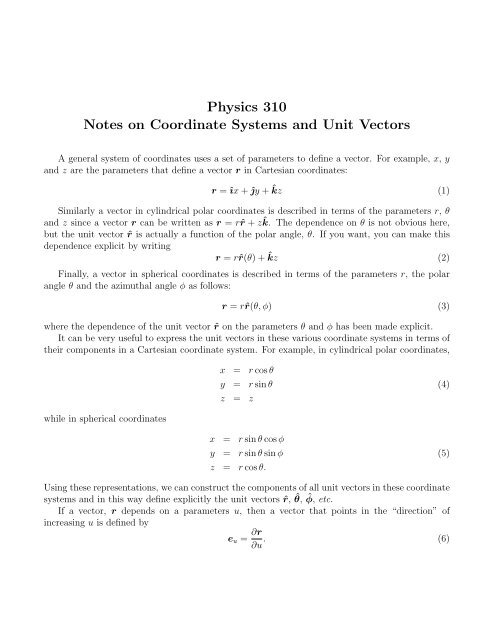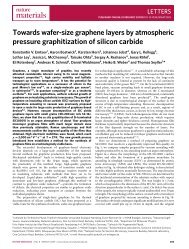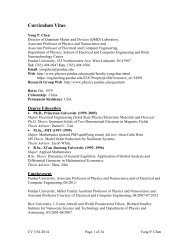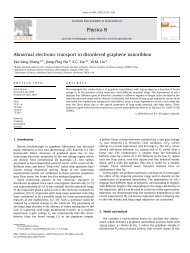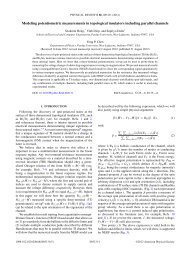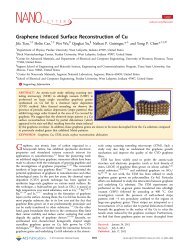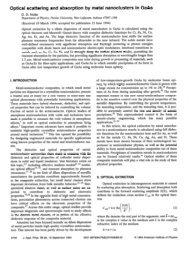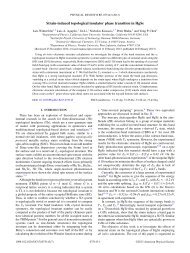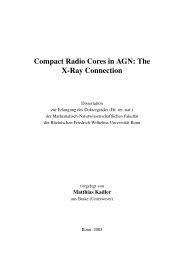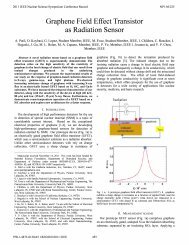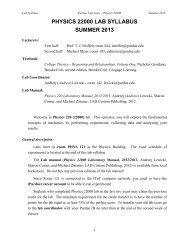Physics 310 Notes on Coordinate Systems and Unit Vectors
Physics 310 Notes on Coordinate Systems and Unit Vectors
Physics 310 Notes on Coordinate Systems and Unit Vectors
You also want an ePaper? Increase the reach of your titles
YUMPU automatically turns print PDFs into web optimized ePapers that Google loves.
<str<strong>on</strong>g>Physics</str<strong>on</strong>g> <str<strong>on</strong>g>310</str<strong>on</strong>g><str<strong>on</strong>g>Notes</str<strong>on</strong>g> <strong>on</strong> <strong>Coordinate</strong> <strong>Systems</strong> <strong>and</strong> <strong>Unit</strong> <strong>Vectors</strong>A general system of coordinates uses a set of parameters to define a vector. For example, x, y<strong>and</strong> z are the parameters that define a vector r in Cartesian coordinates:r = îx + ĵy + ˆkz (1)Similarly a vector in cylindrical polar coordinates is described in terms of the parameters r, θ<strong>and</strong> z since a vector r can be written as r = rˆr + zˆk. The dependence <strong>on</strong> θ is not obvious here,but the unit vector ˆr is actually a functi<strong>on</strong> of the polar angle, θ. If you want, you can make thisdependence explicit by writingr = rˆr(θ) + ˆkz (2)Finally, a vector in spherical coordinates is described in terms of the parameters r, the polarangle θ <strong>and</strong> the azimuthal angle φ as follows:r = rˆr(θ, φ) (3)where the dependence of the unit vector ˆr <strong>on</strong> the parameters θ <strong>and</strong> φ has been made explicit.It can be very useful to express the unit vectors in these various coordinate systems in terms oftheir comp<strong>on</strong>ents in a Cartesian coordinate system. For example, in cylindrical polar coordinates,while in spherical coordinatesx = r cos θy = r sin θ (4)z = zx = r sin θ cos φy = r sin θ sin φ (5)z = r cos θ.Using these representati<strong>on</strong>s, we can c<strong>on</strong>struct the comp<strong>on</strong>ents of all unit vectors in these coordinatesystems <strong>and</strong> in this way define explicitly the unit vectors ˆr, ˆθ, ˆφ, etc.If a vector, r depends <strong>on</strong> a parameters u, then a vector that points in the “directi<strong>on</strong>” ofincreasing u is defined bye u = ∂r∂u . (6)
This vector is not necessarily normalized to have unit length, but from it we can always c<strong>on</strong>structthe unit vectorê u = e u(7)|e u |We will apply this definiti<strong>on</strong> to the Cartesian, cylindrical <strong>and</strong> spherical coordinate systems toillustrate the c<strong>on</strong>structi<strong>on</strong> of their unit vectors.The case of Cartesian coordinates is almost trivial:e x = ∂r∂x = î (8)e y = ∂r∂y = ĵ (9)e z = ∂r∂z = ˆk. (10)It also turns out that each of these vectors is already normalized to have unit length.In the case of cylindrical polar coordinates, using Equati<strong>on</strong>s 2 <strong>and</strong> 4,e r = ∂r∂r = ˆr(θ)= î cos θ + ĵ sin θ, (11)e θ = ∂r∂θ = r ∂ˆr∂θ= −îr sin θ + ĵr cos θ, (12)e z = ∂r∂z = k (13)The unit vectors ˆr <strong>and</strong> ˆθ are the c<strong>on</strong>structed using Equati<strong>on</strong> 7 as follows:ˆr =e r√cos2 θ + sin 2 θ = e r (14)ˆθ =e θr √ sin 2 θ + cos 2 θ = e θrso it turns out that e r was already normalized to unit length.For the last example, in spherical coordinates, using Equati<strong>on</strong>s 3 <strong>and</strong> 5,(15)e r = ∂r = ˆr(θ, φ)∂r= î sin θ cos φ + ĵ sin θ sin φ + ˆk cos θ, (16)
e φ = ∂r∂φ = r ∂ˆr∂φ= −îr sin θ sin φ + ĵr sin θ cos φ, (17)e θ = ∂r∂θ = r ∂ˆr∂θ= îr cos θ cos φ + ĵr cos θ sin φ − ˆkr sin θ (18)The unit vectors ˆr, ˆφ <strong>and</strong> ˆθ are the c<strong>on</strong>structed using Equati<strong>on</strong> 7 as follows:ˆr =ˆφ =ˆθ =e r√sin 2 θ(sin 2 φ + cos 2 φ) + cos 2 θ =e φ√r sin θ sin 2 φ + cos 2 φe θ= e φr sin θ√r sin 2 θ(sin 2 φ + cos 2 φ) + cos 2 θ =e r√sin 2 θ + cos 2 θ = e r (19)e θr √ sin 2 θ + cos 2 θ = e θrso it turns out that e r was already normalized to unit length. From Equati<strong>on</strong> 20 you can see thatthe directi<strong>on</strong> of ˆφ becomes completely undefined when θ = 0 or θ = π.We usually express time derivatives of the unit vectors in a particular coordinate system interms of the unit vectors themselves. Since all unit vectors in a Cartesian coordinate system arec<strong>on</strong>stant, their time derivatives vanish, but in the case of polar <strong>and</strong> spherical coordinates they d<strong>on</strong>ot.In polar coordinates,dˆr= (−î sin θ + ĵ cos θ) dθdtdt = ˆθ ˙θ (22)In spherical coordinates,dˆrdtd ˆφdtdˆθdtdˆθdt= dˆr dθdθ dt + dˆr dφdφ dt(20)(21)= (−î cos θ − ĵ sin θ) dθdt = −ˆr ˙θ (23)= (î cos θ cos φ + ĵ cos θ sin φ − ˆk sin θ) dθ + (−î sin θ sin φ + ĵ sin θ cos φ)dφdt dt= ˆθ ˙θ + ˆφ sin θ ˙φ (24)= −ˆr ˙φ sin θ − ˆφ ˙φ cos θ (25)= −ˆr ˙θ + ˆφ ˙φ cos θ (26)


